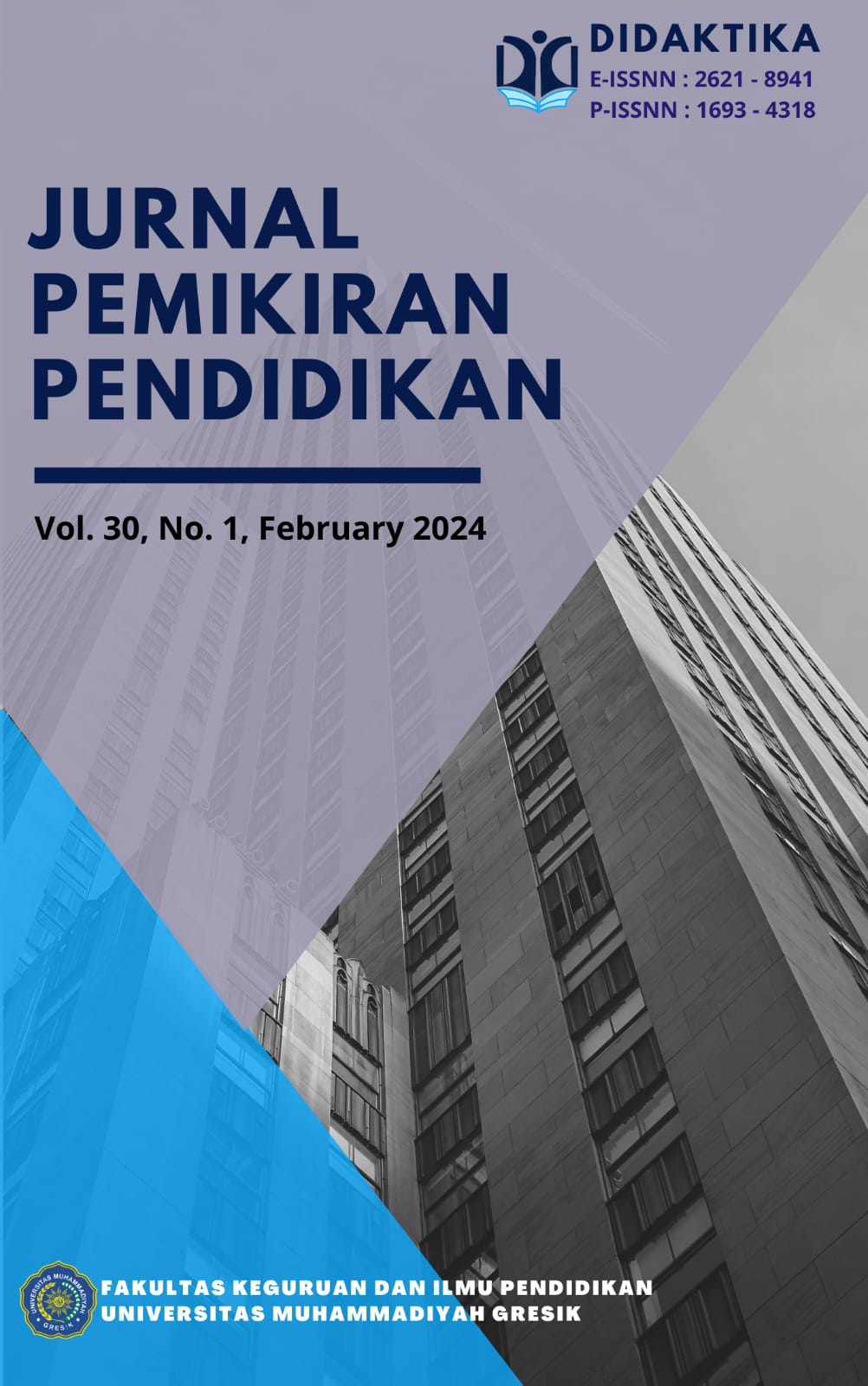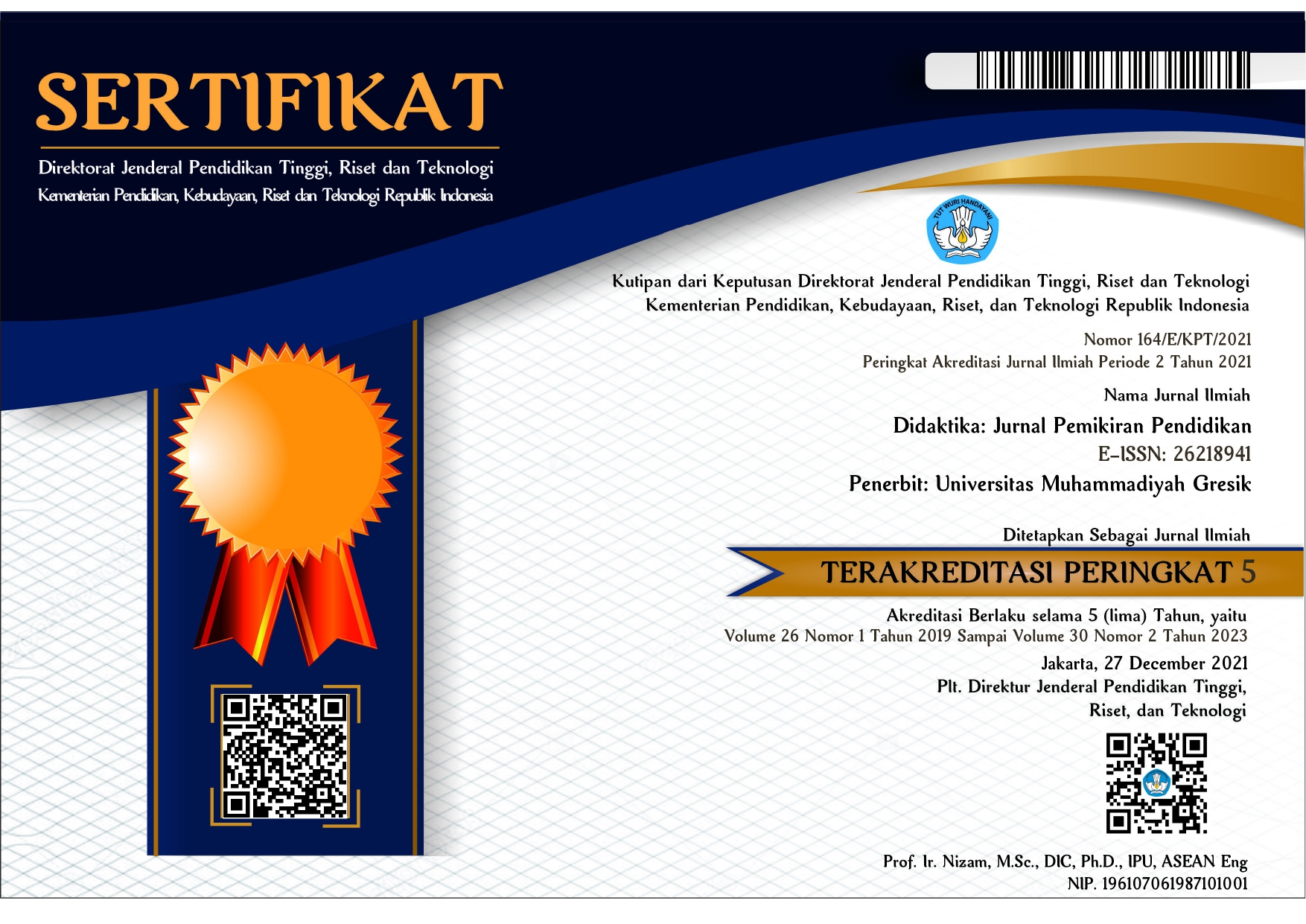Peningkatan Kemampuan Penalaran Matematika Melalui Pembelajaran Berdiferensiasi di SMP Negeri 4 Waru
DOI:
https://doi.org/10.30587/didaktika.v30i1.7431Keywords:
Penalaran, Kemampuan, Matematika, Pembelajaran BerdiferensiasiAbstract
Kemampuan penalaran matematika sangat penting dikembangkan dalam proses pembelajaran matematika. Akan tetapi pada kenyataannya, masih banyak peserta didik yang memiliki kemampuan penalaran matematika yang rendah. Salah satu faktor yang menyebabkan rendahnya kemampuan penalaran peserta didik dalam belajar matematika adalah karena pembelajaran yang didominasi oleh guru. Salah satu metode pembelajaran yang dapat digunakan adalah pembelajaran berdiferensiasi yang dapat memfasilitasi kebutuhan dan karakteristik peserta didik. Jenis penelitian ini adalah Penelitian Tindakan Kelas (PTK). Penelitian ini dilaksanakan di SMP Negeri 4 Waru pada tahun ajawa 2022/2023. Subjek penelitian ini adalah peserta didik kelas VII-3 yang berjumlah 36 peserta didik. Penelitian ini dilakukan melalui tiga tahapan yaitu perencanaan (plan), pelaksanaan (do), dan pengamatan dan refleksi (see), dimana penelitian ini akan berhenti jika terdapat peningkatan kemampuan penalaran matematika peserta didik. Hasil data yang diperoleh menunjukkan bahwa pembelajaran berdiferensiasi mampu meningkatkan kemampuan penalaran matematika peserta didik. Pembelajaran berdiferensiasi telah meningkatkan kemampuan penalaran matematika peserta didik kelas VII-3 SMP Negeri 4 Waru. Pada saat awal, kemampuan penalaran matematika peserta didik kelas VII-3 SMP Negeri 4 Waru mencapai 20% dengan kualifikasi sangat rendah. Pada siklus I, kemampuan penalaran matematika peserta didik kelas VII-3 SMP Negeri 4 Waru meningkat menjadi 53% dengan kualifikasi sangat rendah. Pada siklus II, kemampuan penalaran matematika peserta didik kelas VII-3 SMP Negeri 4 Waru meningkat menjadi 70% dengan kualifikasi sedang.
References
Ahmad, H. (2015). Peningkatan Kemampuan Penalaran Matematika Materi Trigonometri Melalui Penerapan Model Pembelajaran Discovery Learning dengan Pendekatan Saintifik pada Kelas X SMA Negeri 11 Makasar. 1, 1–27.
Aprilianti, Y., & Zanthy, L. S. (2019). Analisis Kemampuan Penalaran Matematik Siswa Smp Pada Materi Segiempat Dan Segitiga. Journal On Education, 01(02), 524–532. https:core.ac.uk/download/pdf/268404943.pdf
Asdarina, O., & Ridha, M. (2020). Analisis Kemampuan Penalaran Matematis Siswa Dalam Menyelesaikan Soal Setara Pisa Konten Geometri. Numeracy, 7(2), 192–206. https://doi.org/10.46244/numeracy.v7i2.1167
Azizzah, N. N., Pramuditya, S. A., & Rosita, C. D. (2023). ANALISIS KEMAMPUAN PENALARAN MATEMATIS BERDASARKAN GAYA BELAJAR SISWA MELALUI PENDEKATAN PEMBELAJARAN BERDIFERENSIASI. 9, 13–20.
d’Entremont, Y. (2015). Linking Mathematics, Culture and Community. Procedia - Social and Behavioral Sciences, 174(1999), 2818–2824. https://doi.org/10.1016/j.sbspro.2015.01.973
Drupadi, S. W., & Mumu, J. (2018). Analisis Kemampuan Penalaran Induktif Matematis Mahasiswa Pendidikan Matematika Universitas Papua. Journal of Honai Math, 1(2), 113. https://doi.org/10.30862/jhm.v1i2.1048
Gunawan, H., Rif’at, M., & Sayu, S. (2020). Influence of Problem Based Learning Model on Students’ Mathematical Reasoning Ability. International Journal of Learning Instruction, 1538(1), 95–98. https://doi.org/10.1088/1742-6596/1538/1/012078
Haryanti, C. F., & Masriyah. (2018). MATHE dunesa. Jurnal Ilmiah Pendidikan Matematika, 7(2), 197–204. https://jurnalmahasiswa.unesa.ac.id/index.php/mathedunesa/article/view/25554/23429
Hasanah, S. I., Tafrilyanto, C. F., & Aini, Y. (2019). Mathematical Reasoning: The characteristics of students’ mathematical abilities in problem solving. Journal of Physics: Conference Series, 1188(1). https://doi.org/10.1088/1742-6596/1188/1/012057
Izzah, K. H., & Azizah, M. (2019). Analisis Kemampuan Penalaran Siswa dalam Pemecahan Masalah Matematika Siswa Kelas IV. Indonesian Journal of Educational Research and Review, 2(2), 1–7. https://doi.org/10.33654/jpl.v14i2.881
Kamal, S. (2021). Implementasi Pembelajaran Berdiferensiasi. Jurnal Pembelajaran Dan Pendidikan , Volume 1 N(September 2021), 1–12.
Khoeriyah, D. A. N., & Ahmad, A. (2020). Penerapan Model Pembelajaran Problem Solving Dengan Pendekatan Saintifik Pada Kemampuan Penalaran Matematis Siswa Kelas VIII B SMP Negeri 1 Padamara. AlphaMath : Journal of Mathematics Education, 6(1), 62. https://doi.org/10.30595/alphamath.v6i1.7943
Maidiyah, E., Anwar, N., Mailizar, M., Zaura, B., Suryawati, S., & Harnita, F. (2021). Mathematical Reasoning Ability of Junior High School Students Through Problem Based Learning Model with Ethnomathematical Nuance. Kreano, Jurnal Matematika Kreatif-Inovatif, 12(2), 276–287. https://doi.org/10.15294/kreano.v12i2.30497
Mariyam, M., & Wahyuni, R. (2016). Mengembangkan Kemampuan Penalaran Matematis Siswa Melalui Problem Centered Learning Pada Materi Peluang (Studi Eksperimen Di Kelas VIII SMP N 6 Singkawang). JPMI (Jurnal Pendidikan Matematika Indonesia), 1(2), 74. https://doi.org/10.26737/jpmi.v1i2.86
Mendrofa, N. K., Dewi, I., Simamora, E., & Nias, U. (2022). Mathematics Learning Based on Multicultural Education to Realize Pancasila Students. 6(2), 281–293.
Saragih, S., Napitupulu, E. E., & Fauzi, A. (2017). Developing Learning Model Based on Local Culture and Instrument for Mathematical Higher Order Thinking Ability. International Education Studies, 10(6), 114. https://doi.org/10.5539/ies.v10n6p114
Syarifuddin, & Nurmi. (2022). Pembelajaran Berdiferensiasi dalam Meningkatkan Hasil Belajar Matematika Siswa Kelas IX Semester Genap SMP Negeri 1 Wera Tahun Pelajaran 2021 / 2022. 2, 93–102.
Tomlinson, C. A. (2011). Differentiate instruction in mixed-ability classrooms. https://d1wqtxts1xzle7.cloudfront.net/44098361/_Carol_Ann_Tomlinson__How_to_Differentiate_InstrucBookSee.org-with-cover-page-v2.pdf?Expires=1631251576&Signature=YZi5pSld61OpLx2~tuG4isXixDt0Sg9yLDjEz0yeUm1X~y576UCjpIIUsfAzAEMlyH2OtfXM~95owzfu8j8R6kQCZ3v6IE
Wahyudin. (2018). Etnomatematika Dan Pendidikan Matematika Multikultural. Prosiding Seminar Nasional Pendidikan Matematika Etnomatnesia, 1–19.
Downloads
Published
How to Cite
Issue
Section
License
License and Copyright Agreement
In submitting the manuscript to the journal, the authors certify that:
- They are authorized by their co-authors to enter into these arrangements.
- The work described has not been formally published before, except in the form of an abstract or as part of a published lecture, review, thesis, or overlay journal.
- That it is not under consideration for publication elsewhere,
- That its publication has been approved by all the author(s) and by the responsible authorities – tacitly or explicitly – of the institutes where the work has been carried out.
- They secure the right to reproduce any material that has already been published or copyrighted elsewhere.
- They agree to the following license and copyright agreement.
Copyright
Authors who publish with DIDAKTIKA: Jurnal Pemikiran Pendidikan agree to the following terms:
- Authors retain copyright and grant the journal right of first publication with the work simultaneously licensed under a Creative Commons Attribution License (CC BY-SA 4.0) that allows others to share the work with an acknowledgment of the work's authorship and initial publication in this journal.
- Authors are able to enter into separate, additional contractual arrangements for the non-exclusive distribution of the journal's published version of the work (e.g., post it to an institutional repository or publish it in a book), with an acknowledgment of its initial publication in this journal.
- Authors are permitted and encouraged to post their work online (e.g., in institutional repositories or on their website) prior to and during the submission process, as it can lead to productive exchanges, as well as earlier and greater citation of published work.
Licensing for Data Publication
Open Data and Software Publishing and Sharing
The journal strives to maximize the replicability of the research published in it. Authors are thus required to share all data, code or protocols underlying the research reported in their articles. Exceptions are permitted but have to be justified in a written public statement accompanying the article.
Datasets and software should be deposited and permanently archived inappropriate, trusted, general, or domain-specific repositories (please consult http://service.re3data.org and/or software repositories such as GitHub, GitLab, Bioinformatics.org, or equivalent). The associated persistent identifiers (e.g. DOI, or others) of the dataset(s) must be included in the data or software resources section of the article. Reference(s) to datasets and software should also be included in the reference list of the article with DOIs (where available). Where no domain-specific data repository exists, authors should deposit their datasets in a general repository such as ZENODO, Dryad, Dataverse, or others.
Small data may also be published as data files or packages supplementary to a research article, however, the authors should prefer in all cases a deposition in data repositories.











